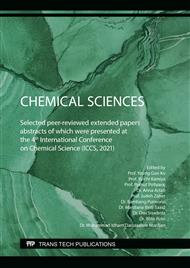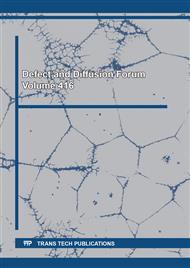[1]
P. Ramaswamy, N.E. Wong, G.K. Shimizu, MOFs as proton conductors–challenges and opportunities, Chem. Soc. Rev. 43 (2014) 5913–5932.
DOI: 10.1039/c4cs00093e
Google Scholar
[2]
S.D.P. Cabello, S. Mollá, N.A. Ochoa, J. Marchese, E. Giménez, V. Compañ, New bio-polymeric membranes composed of alginate-carrageenan to be applied as polymer electrolyte membranes for DMFC, J. Power Sources 265 (2014) 345–355.
DOI: 10.1016/j.jpowsour.2014.04.093
Google Scholar
[3]
K. Divya, M.S.A. Saraswathi, D. Rana, A Nagendran, Non-Nafion-based cation exchange membranes for direct methanol fuel cells, in: K. Dutta (Eds.), Direct Methanol Fuel Cell Technology, Elsevier, 2020, p.37–70.
DOI: 10.1016/b978-0-12-819158-3.00003-3
Google Scholar
[4]
P.C. Li, G.M. Liao, S.R. Kumar, C.M. Shih, C.C. Yang, D.M. Wang, S.J. Lue, Fabrication and characterization of chitosan nanoparticle-incorporated quaternized poly(vinyl alcohol) composite membranes as solid electrolytes for direct methanol alkaline fuel cells, Electrochim. Acta 187, (2016) 616–628.
DOI: 10.1016/j.electacta.2015.11.117
Google Scholar
[5]
M. Goor, S. Menkin, E. Peled, High power direct methanol fuel cell for mobility and portable applications, Int. J. Hydrogen Energy 44 (2019) 3138–3143.
DOI: 10.1016/j.ijhydene.2018.12.019
Google Scholar
[6]
S. Basri, S.K. Kamarudin, W.R.W. Daud, Z. Yaakub, M.M. Ahmad, N. Hashim, U.A. Hasran, Unsteady-state modelling for a passive liquid-feed DMFC, Int. J. Hydrogen Energy 34 (2009) 5759–5769.
DOI: 10.1016/j.ijhydene.2009.05.092
Google Scholar
[7]
C.A.R. Cotton, N.J. Claassens, S. Benito-Vaquerizo, A. Bar-Even, Renewable methanol and formate as microbial feedstocks, Curr. Opin. Biotechnol. 62 (2020) 168–180.
DOI: 10.1016/j.copbio.2019.10.002
Google Scholar
[8]
N. Shaari, S.K. Kamarudin, chitosan and alginate types of bio-membrane in fuel cell application: An overview, J. Power Sources 289 (2015) 71–80.
DOI: 10.1016/j.jpowsour.2015.04.027
Google Scholar
[9]
A. Kakoria, S. Sinha-Ray, A review on biopolymer-based fibers via electrospinning and solution blowing and their applications, Fibers 6 (2018) 45.
DOI: 10.3390/fib6030045
Google Scholar
[10]
M.S.M. Eldin, A.E. Hashem, T.M. Tamer, A.M. Omer, M.E. Yossuf, M.M. Sabet, Development of crosslinked chitosan/alginate polyelectrolyte proton exchanger membranes for fuel cell applications, Int. J. Electrochem. Sci. 12, (2017) 3840–3858.
DOI: 10.20964/2017.05.45
Google Scholar
[11]
B. Zhu, H. Yin, Alginate lyase: Review of major sources and classification, properties, structure-function analysis and applications, Bioengineered 6 (2015) 125–131.
DOI: 10.1080/21655979.2015.1030543
Google Scholar
[12]
I.D. Hay, Z.U. Rehman, M.F. Moradali, Y. Wang, B.H.A. Rehm, Microbial alginate production, modification and its applications, Microb. Biotechnol. 6 (2013) 637–650.
DOI: 10.1111/1751-7915.12076
Google Scholar
[13]
A.R. Kaveeshwar, M. Sanders, S.K. Ponnusamy, D. Depan, R. Subramaniam, Chitosan as a biosorbent for adsorption of iron (II) from fracking wastewater, Polym. Adv. Technol. 29 (2018) 961–969.
DOI: 10.1002/pat.4207
Google Scholar
[14]
S. Mohanapriya, V. Raj, Cesium-substituted mesoporous phosphotungstic acid embedded chitosan hybrid polymer membrane for direct methanol fuel cells, Ionics 24 (2018) 2729–2743.
DOI: 10.1007/s11581-017-2406-1
Google Scholar
[15]
H. Ilbeygi, I.Y. Kim, M.G. Kim, W. Cha, P.S.M. Kumar, D.H. Park, A. Vinu, Highly crystalline mesoporous phosphotungstic acid: a high‐performance electrode material for energy‐storage applications, Angew. Chem. Int. Ed. 58 (2019) 10849–10854.
DOI: 10.1002/anie.201901224
Google Scholar
[16]
M. Yamada, I. Honma, Heteropolyacid-encapsulated self-assembled materials for anhydrous proton-conducting electrolytes, J. Phys. Chem. B 110 (2006) 20486–20490.
DOI: 10.1021/jp063488k
Google Scholar
[17]
M. Tohidian, S.R. Ghaffarian, S.E. Shakeri, E. Dashtimoghadam, M.M. Hasani-Sadrabadi, Organically modified montmorillonite and chitosan/phosphotungstic acid complex nanocomposites as high-performance membranes for fuel cell applications, J. Solid State Electrochem. 17 (2013) 2123–2137.
DOI: 10.1007/s10008-013-2074-7
Google Scholar
[18]
B. Smitha, S. Sridhar, A.A. Khan, Chitosan–sodium alginate polyion complexes as fuel cell membranes, Eur. Polym. J. 41 (2005) 1859–1866.
DOI: 10.1016/j.eurpolymj.2005.02.018
Google Scholar
[19]
A. Pancho, C. Díaz, O. Sotomayor, Influence of Fe on the microstructure and mechanical properties of low Al-SI alloys, Int. J. Microstruct. Mater. Prop. 13 (2018) 317–330.
DOI: 10.1504/ijmmp.2018.10018201
Google Scholar
[20]
H. Junoh, J. Jaafar, N.A.H.M. Nordin, A.F. Ismail, M.H.D. Othman, M. Rahman, A.N. Yusof, Synthetic polymer-based membranes for direct methanol fuel cell (DMFC) applications, in: Synthetic Polymeric Membranes for Advanced Water Treatment, Gas Separation, and Energy Sustainability, Elsevier, 2020, p.337–363.
DOI: 10.1016/b978-0-12-818485-1.00015-0
Google Scholar
[21]
D. Permana, M. Purwanto, L.O.A.N. Ramadhan, L. Atmaja, Synthesis and characterization of chitosan/phosphotungstic acid-montmorillonite modified by silane for DMFC membrane, Indones. J. Chem. 15 (2015) 218–225.
DOI: 10.22146/ijc.21188
Google Scholar
[22]
F. Altaf, R. Batool, R. Gill, M.A. Shabir, M. Drexler, F. Alamgir, K.I. Jacob, Novel N-p-carboxy benzyl chitosan/poly (vinyl alcohol/functionalized zeolite mixed matrix membranes for DMFC applications, Carbohydr. Polym. 237 (2020) 116111.
DOI: 10.1016/j.carbpol.2020.116111
Google Scholar



